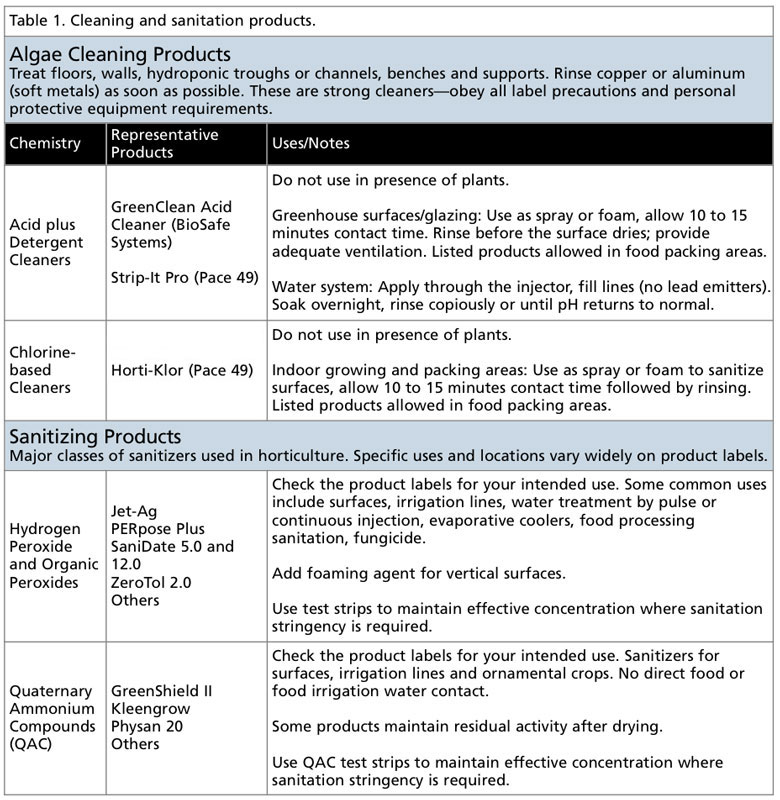6/1/2020
Algae Growth: How to Prevent a Slippery Slope
Karen Stever
Algae on a floor or walkway is a known slipping hazard. It ranks right up there with cartoon banana peels or a bunch of marbles on the floor! That means algae is no laughing matter in your production or sales areas. Moreover, the risks associated with algae extend beyond human injury.
Where can algae grow?
On the soil surface in pots, algae can interfere with water penetration and drying of the soil. Its growth robs the plant of nutrients and decreases the soil oxygen levels. Algae can also grow on the foliage, blocking light required for photosynthesis. As if interfering with growth isn’t enough, algae also provides a hatchery and food source for both fungus gnat (sciaridae) and shore fly larvae (ephydridae) wherever it exists.
Does algae affect plant growth?
In hydroponic production, algae can have an even more “interesting” effect, at least for those with either a dark sense of humor or a love of science. Unchecked algal growth can cause extreme pH swings in recirculated hydroponic systems of 1 to 2 pH units. This can cause growers or automated controllers to wildly ping-pong back and forth, alternately adding acid and base in a quest for acceptable pH readings throughout the day. The pH swings occur with the light and dark cycles as photosynthesis is carried out by the algae. (Carbon dioxide exists in water as a weak acid, carbonic acid.)
During photosynthesis, as carbonic acid is used, the pH of the water will rise. During dark hours, CO2 will re-equilibrate between the air and water, lowering the solution pH again. At this level of algal infestation, shore flies and fungus gnats may flourish. Additionally, decomposing dead algae removes oxygen from the water, depriving the roots.
Preventing the establishment of algae is the most effective control strategy. Once algae takes up residence, a grower is sliding down that metaphorical slippery slope, grasping for control. It can be hard to reign in this green slime (as well as the black, brown or red genera). For prevention, it helps to understand how algae spreads and where the inoculum lurks within your production areas.
How does algae reproduce and spread?
Algae reproduce by both sporulation and by simple cell division. Spores can be airborne and can cling to greenhouse surfaces, including the greenhouse glazing, where they can persist for some time. When the spores drift to an area of ample moisture, growth begins. Thorough cleaning of the empty production space, using either an acidic cleaner or chlorine-based cleaning product, will kill the algal masses on plant supports, floors and surfaces. Cleaning is followed up with a disinfecting sanitizer to eliminate residual algal spores on surfaces. (The chemical class of products commonly used is listed in Table 1.)
 Algae lurking in the water system is the leading cause of algae growth on soil surfaces. Contaminated water lines provide a continual source of inoculum for hydroponic systems, drip irrigation systems, walkways and other greenhouse surfaces. Water systems are best cleaned when no plants are on the line or in the greenhouse. Strongly acidic cleaners, like GreenClean Acid Cleaner or Strip-It Pro, break down the algae, biofilms and the mineral deposits that build up. Once algae has been dealt a deadly blow, a sanitizer should be used to disinfect the water system.
Algae lurking in the water system is the leading cause of algae growth on soil surfaces. Contaminated water lines provide a continual source of inoculum for hydroponic systems, drip irrigation systems, walkways and other greenhouse surfaces. Water systems are best cleaned when no plants are on the line or in the greenhouse. Strongly acidic cleaners, like GreenClean Acid Cleaner or Strip-It Pro, break down the algae, biofilms and the mineral deposits that build up. Once algae has been dealt a deadly blow, a sanitizer should be used to disinfect the water system.
For algae control in and around crops, several of the sanitizer products listed can be used for preventative maintenance, either periodically or by continuous injection in the water. Furthermore, oxidizing sanitizers, such as SaniDate12.0 or ZeroTol 2.0, can be used to clean irrigation lines while “in use.”
After soaking the system overnight with an oxidizer, the bulk of the algae and sanitizer is flushed through an opened drain valve before irrigation, since it may not be fully broken down. This cleaning may need to be repeated for highly fouled water lines. GT
Karen Stever is a GGSPro Technical Support Representative for Griffin. She can be reached at ggsprotech@griffinmail.com.